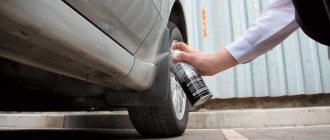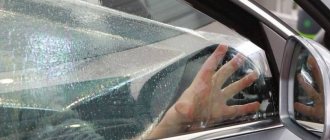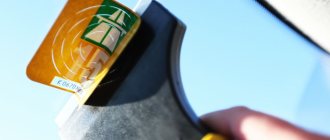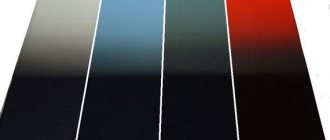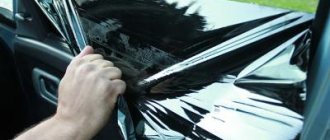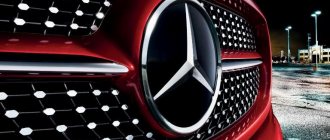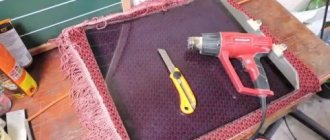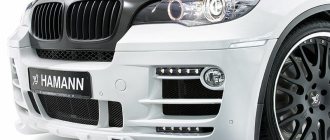One peek at the history, differences from ceramics, what it does and what it protects from, real service life, how to care for it and how to apply it.
By default, it is considered that the “homeland” of the H7 coating is Japan. Although this is more of a presumption, because clear facts to confirm this cannot be found in the public domain. Common in most countries where there are asphalt roads for cars to drive on. Even those that are slightly more expensive than a horse-drawn cart.
The traditional, international name of the composition is “Glass coat”. Translated as liquid coating or liquid layer. But the Russian detailer found this dissonant and decided to translate it with the “pleasing to the ear” combination “liquid glass.” Laughter, laughter, and today the reverse translation - “liquid glass” is quite “Googled” on foreign sites. We can say that the domestic detailer made his contribution to the formation of world trends.
Today there are many manufacturers of liquid glass. There are local brands, there are global ones, there are leaders in Eastern Europe, and there are leaders in Western Europe. There are many Asian formulations, from the box of which the hieroglyphs and crocodiles were removed, replacing them with the Latin alphabet we are familiar with.
Which brands are better, which are worse and which composition to choose for your car - we’ll figure it out below, but for now let’s look at the conceptual features of liquid glass for car bodies.
Differences between liquid glass and ceramics
It is more expensive than carnauba wax, works longer, performs the same functions, but gives a better overall result.
On the other hand, liquid glass is compared to ceramics. Quite reasonable: the bottles are similar, the names of both are ornate, the difference in cost evens out every year.
BMW at the Brilliant Detail detailing center after combined protection liquid glass +TOP COAT in May 2021.
Liquid glass has a better hydrophobe. It is more pronounced. But ceramics add depth of color, contrast, and hardness. The ceramic bottle says “H9”, but the glass bottle only says “H7”. Nine is more than seven and therefore ceramics are cooler. This is a dogma for “old believer detailers” who still believe that ceramics protect against scratches.
In fact, you shouldn’t compare it head-on with ceramics. Both compositions are about protection and about aesthetics, but they are complementary rather than mutually exclusive.
This is a composition that contains less “base” but the meaning remains the same as ceramics.
Less base, better hydrophobe, more base, the varnish becomes harder, everything is quite simple. I deliberately do not talk here about “closure compositions” like TOP COAT, so as not to confuse you.
Kia Stinger after liquid glass at the Brilliant Detail detailing center in May 2021
How much-how much?
The cost of materials from the professional line from different manufacturers and different representatives is approximately comparable. The question is how many layers are applied, what are the dimensions of the car, what is the scope of work. The price will depend on this. And the fork can be very wide. So, if for a golf-class car they tell you the cost is 700 rubles, then for a premium crossover like the BMW X5 it can be 2-3 thousand rubles.
“But this also includes working with the interior: glass, plastic, leather, wheel processing. Different volumes of work – hence the price range,” explain the detailing studio specialists. A special composition for the skin protects it from ultraviolet radiation and gives a hydrophobic effect, but at the same time the material can “breathe”. The composition for plastic creates a polymer film that restores color, and the material itself suffers less from mechanical damage. There is a special product for glass. As in the case of paintwork, the surfaces to be treated are pre-cleaned and prepared for application of the compositions.
The principle of operation of liquid glass on cars
The composition is evenly applied to the prepared paintwork of the car body (the application technology will be discussed below). Glass, unlike ceramics, is not absorbed into anything or anywhere, but hardens into an even film on the surface of the varnish and, after the crystallization process is completed, acquires all the declared properties: resistance to UV rays, resistance to aggressive chemical environments and a high contact angle (hydrophobicity).
Cars of clients of the Brilliant Detail detailing center awaiting their owners
What does liquid glass protect cars from?
The coating on a car is a transparent polymer film based on silicon oxide, several hundred nanometers thick. Therefore, it is stupid and naive to hope for complete protection against chips and abrasions. It's like trying to stop a bullet with a plastic bag. We need armored films here.
It will save or delay damage to your car's paintwork as a result of oxidation of bird droppings. Will take on highly alkaline shampoos at car washes, acidic precipitation, industrial dust, reagents and oil stains from the road, bitumen and tree resin deposits. Will not allow premature formation of static on paintwork. Due to the long-lasting hydrophobe, it will allow the body to remain acceptably clean for much longer. As a result, micro scratches and cobwebs on the body from rags after visiting car washes are reduced several times.
Mercedes GLS in the Brilliant Detail detailing center under the protection of Glass Coat
Materials and tools
To properly coat a car with liquid glass, you need to stock up on all the necessary tools and materials in advance. For this you will need:
- sponge and brush for pre-washing the body;
- car shampoo;
- a towel for wiping the surface dry;
- clay for cleaning the body from bitumen stains and other inclusions;
- degreaser;
- the polish itself and microfiber (often supplied in the kit).
If a spray polish is selected, a manual spray attachment is usually sold together. For formulations in bottles, direct application to rags is also acceptable, so no other equipment is required. If a two-component product (with a hardener) is used, prepare a container for mixing and a spatula or spoon for manipulation.
Cost of coating with liquid glass
| Body coating | Motorcycles | Small cars | Average cars | Business class and crossovers | Executive, SUVs, minivans and minibuses |
| Ceramic coatings | |||||
| Ceramic Pro 9H 2 layers +Ceramic Pro Light | 12000 | 25000 | 28000 | 32000 | 37000 |
| Ceramic Pro 9H 4 layers + Ceramic Pro Light | 18000 | 42000 | 45000 | 50000 | 55000 |
| Ceramic Pro 9H 6 layers+ Ceramic Pro Light | 25000 | 62000 | 67000 | 72000 | 77000 |
| Ceramic Pro 9H 8 layers + Ceramic Pro Light | 35000 | 82000 | 87000 | 92000 | 97000 |
| Ceramic Pro PPF&Vinyl + Ceramic Pro PPF&Vinyl Top Coat | 10000 | 20000 | 25000 | 28000 | 30000 |
| GEYON Q²SYNCRO two-component ceramic coating | 10500 | 20000 | 22000 | 24000 | 26000 |
| GEYON Q² DuraFlex | 10000 | 28000 | 30000 | 35000 | 40000 |
| GEYON Q² DuraBead | 10000 | 22000 | 25000 | 30000 | 35000 |
| GYEON Q² Matte | 10000 | 25000 | 30000 | 32000 | 35000 |
| Liquid glass | |||||
| Liquid glass coating Ceramic Pro Light | 5000 | 10000 | 11000 | 13000 | 15000 |
| Ceramic Pro PPF&Vinyl Top Coat | 2000 | 5000 | 6000 | 7000 | 8000 |
| Willson liquid glass coating | 4000 | 8000 | 9000 | 10000 | 12000 |
| Quartz coatings | |||||
| Quartz coating GYEON ONE | 2500 | 4800 | 5500 | 6500 | 7500 |
| Quartz coating GYEON CAN COAT | 2000 | 4000 | 4500 | 5500 | 6000 |
| Polishing | Motorcycles | Small cars | Average cars | Business class and crossovers | Executive, SUVs, minivans and minibuses |
| Restorative polishing | 5000 | 10000-15000 | 12000-17000 | 15000-20000 | 17000-25000 |
| Detailing polishing | 4000 | 12000 | 15000 | 17000 | 25000 |
| Protective polishing | 2000 | 6000 | 7000 | 8000 | 10000 |
| Polishing headlights or taillights | 1000 | 2000 | 2000 | 2500 | 3000 |
| Polishing interior inserts | from 2000 | from 2000 | from 2000 | from 2000 | |
| Windshield polishing | 5000 | 6000 | 7000 | 8000 | |
| Rear window polishing | 3000 | 4000 | 5000 | 6000 | |
| Local polishing | from 1000 | from 1000 | from 1000 | from 1000 | from 1000 |
| Body | Motorcycles | Small cars | Average cars | Business class and crossovers | Executive, SUVs, minivans and minibuses |
| Detailing wash | 1100 | 7400 | 8100 | 9100 | 9600 |
| Engine compartment detailing | 4000 | 4500 | 5000 | 5000 | |
| Wheel and caliper detailing | 1000 | 3000-4000 | 3000-4000 | 4000 | 5000 |
| Detailing wheel arches and suspension | 2000 | 3000-4000 | 3000-4000 | 4000-5000 | 5000-6000 |
| Detailing plastic inserts and rubber surfaces | 1500 | 2000-5000 | 2500-5000 | 3000-6000 | 4000-7000 |
| Cleaning with clay | 1000 | 1500-3000 | 2000-4000 | 3000-6000 | 4000-7000 |
| Ceramic coating for rims | |||||
| CERAMIC PRO WHEEL&CALIPER | 2500 | 5000 | 5500 | 6000 | 7000 |
| GYEON Q² Rim | 2000 | 4000 | 5000 | 6000 | 6000 |
| Protective coating for glass surfaces | |||||
| Ceramic Pro Rain | 3500 | 4000 | 4500 | 5000 | |
| GYEON Q² View | 3500 | 4000 | 4500 | 5000 | |
| Protective coating for plastic | |||||
| CERAMIC PRO PLASTIC | 2000 | 4500 | 5000 | 5500 | 6500 |
| GYEON Q² TRIM | 1000 | 4000 | 4500 | 5000 | 5500 |
Actual service life
Manufacturers promise on their websites, in instructions and at exhibitions that if the application technology and operating rules are followed, its protective properties will last up to 24 months. Perhaps this is so, but...
We live in Moscow, where roads are repaired more often than they are washed. Where the rains nail all the emissions from local thermal power plants and factories to the ground. Where there is snow in winter, which means winter brushes for sweeping away snow. Where those who work at car washes are the ones who saw a four-wheeled car for the first time yesterday (no offense). Where dirt from dividing strips and lawns is drained onto the road. Where a winter reagent corrodes leather boots in a couple of days...
Let's be realistic. If all rules and technologies are followed during application, it will last up to 4 months. If you exclude “animal washers”, winter brushes and aggressive chemicals (shampoos, waxes, isopropyl anti-freeze...) you can actually extend the service life to 8 months.
BMW of a regular customer of the Brilliant Detail detailing center on corrective polishing and protection with one layer of liquid glass
Polishing
After applying the glass coating, it is important to polish it quickly. To do this, use microfiber (yellow or blue), supplied in the kit. The action is performed in a circular motion, sequentially passing through the treated area. You need to rub until the effect of deep paintwork color without whitish streaks appears.
Important! When applying, you don’t need too much of the compound, since the paintwork will stick to itself a thin layer, and the rest will have to be cleaned off during polishing.
Since bodywork is carried out in segments, pay attention to the boundaries of the sections. There may be stains on them. Rub such areas thoroughly with microfiber. To speed up and facilitate the process, you can use a microfiber attachment on a grinder, drill or polishing machine.
Polishing applied liquid glass with a machine
How to care for liquid glass on a car
Above, I touched on the topic of caring for the protective coating on the body of your car. I'll tell you more about it here.
You should not count on “magic” compounds that promise to restore the protective properties of glass. Spray, wipe and you're done. It doesn't happen that way. If liquid glass is no longer hydrophobic, shiny, or in any way shows itself positively on the car body, you will have to reapply it.
Glass Coat does not like mechanical contacts. The more often the body is wiped with rags at regular car washes, the faster the protective layer will wear off. Use detailing washes, where the body is dried with air, or buy a large microfiber towel for “drying” yourself.
Audi A5 under 2 layers of protection and a layer of TOP COAT at the Brilliant Detail detailing center
Avoid winter brushes, summer brushes, insect repellent wet wipes and other similar mechanical contacts with the body. Also exclude aggressive chemicals that contain any kind of solvents: degreasers, anti-silicones, white spirits, pure methyl or isopropyl alcohol (vodka is fine), smelly anti-freezes, gasoline...
You can: carnauba wax, sealants, detailing show waxes like quick shine, nanoshampoos without active alkali molecules (they are expensive, you can tell them apart right away), delicate cleansers based on a composition of surfactants.
Porsche before being protected with a liquid protective composition after washing and polishing the body at the Brilliant Detail detailing center
Technology of applying liquid glass to cars
Let's talk about the technology of applying liquid glass to a car body. First of all, it is necessary to prepare the paintwork. The principle is simple: the more uniform the surface of the paintwork, the more uniform it will “lie.”
First of all, thoroughly wash the body from road dust, dirt and debris. We wash in three stages: we knock off the top layer of dirt with water pressure and wet the static, then we perform a preliminary contactless wash, and in the third stage we wash the body with a delicate shampoo and a coarse sponge. After everything we dry it with air, without rags or water removers.
BMW under 2 layers of liquid Glass Coat at the Briliant Detail detailing center
The second step is to clean the paintwork from inclusions that have managed to “stick” into the varnish. To do this, we use polishing clay and lubricant. This process is comparable to scrubbing, but is called in a fashionable way - decontamination.
Afterwards we remove all scratches on the paintwork. For a car with mileage and a heavily scratched body, we perform restorative polishing with a sequential combination of abrasive, medium-abrasive and finishing pastes. For new cars or cars with minimal mileage, we do light corrective polishing or get by with local scratch removal.
Toyota Land Cruiser under combined ceramic + liquid glass protection at the Brilliant Detail detailing center
We degrease the prepared body and proceed to applying liquid glass. We apply liquid glass with a special pad using uniform, overlapping movements. We apply to each part in turn. After applying to one part, polish with a soft polishing microfiber, monitoring the skip zones with a diode flashlight.
When the first layer of applying liquid glass to the entire body is completed, you can move on to the next layers. There is no need to smear one part twice in a row.
If you combine ceramics with liquid glass, then apply the ceramics first, then the liquid glass. If you can distinguish TOP COAT from ceramics and liquid glass, then apply ceramics first, then liquid glass, then TOP COAT.
Mercedes after applying liquid glass at the Brilliant Detail detailing center
Surface preparation
Step one. Washing and drying the car outside.
If you do it yourself, then you should take into account that neither foam rubber nor a rag are suitable - they hold small hard particles well, which will certainly cover the body of the body with a mesh of tiny scratches. You need a rubber hose and a soft brush with long bristles.
Hose down the entire car and wait a few minutes for the dirt to soak up. In a bucket, prepare a solution of special car shampoo (only this!) and, dipping a brush into it, clean off all the dirt, constantly watering it with a hose.
Important: be sure to wash with shampoo and not hot water. Otherwise, the smallest dirt will remain in the pores and cracks, which will absorb moisture, and then it will penetrate under the paint. The result will be rust.
But first, clean all the drainage holes in the doors, sills, and front fenders so that water does not get into the cavities and cause further corrosion.
And at the end of the wash, remove all droplets of water with a wrung-out clean suede cloth so that small white spots do not appear in their places due to sunlight.
To complete the first stage, wipe the entire washed surface with a dry soft cloth (napkin).
Step two. Degreasing.
Everything that is not dissolved by water is eliminated.
The entire surface of the dried body is degreased with white spirit. It has a pungent odor, so the room must have good ventilation or you must wear a respirator. Be sure to wear rubber gloves. First, white spirit is applied, after some time the dirt is removed with a soft, lint-free cloth.
Be careful - if the contamination is bitumen, then you need to use special bitumen cleaners. Do not use gasoline, kerosene, etc. under any circumstances. - on varnish and paint. Only possible on bare metal surfaces. Remove old polish. At the end, the body is covered with a cleaning solution, and everything is washed off.
